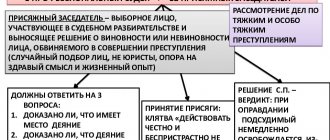Most citizens do not understand the difference between robbery and robbery. At the same time, the punishment of the guilty person, as well as the penalties applied to him, directly depend on the correct classification of these offenses.
The difficulty in correctly determining the type of criminal act committed lies in the fact that they have a common object of encroachment - property owned by someone else. This is the main reason why ordinary people try in these concepts.
Download for viewing and printing:
Criminal Code of the Russian Federation of June 13, 1996 N 63-FZ
The concepts of “robbery” and “robbery”
Characteristics of robbery
This act can be classified from the moment the offender began to commit actions of an illegal nature.
This crime is characterized from all others by a truncated composition, since for qualification it does not matter at all whether the criminal intent was carried through to completion or not. Due to the possibility of causing severe harm to a person, the legislator and the state pay a lot of attention to protecting the population from this type of crime.
The objective part of this criminal act is that the criminal commits it openly, using actions of a violent nature, expressed in danger to human health and life.
Peculiarities of theft qualification: excess of the perpetrator
The excess of the perpetrator is understood as the commission by the perpetrator of a criminal act that was not covered by the intent of other attackers.
Example. A group of young people under 18 years of age, with the goal of enriching themselves at someone else’s expense, attacked their peers not far from the school. In their arsenal, the group of attackers had metal pipes with which they threatened to cause physical harm in order to take away the money. One of the teenagers refused to give the money voluntarily, so one of the attackers invited the others to beat him. He was refused this offer, after which he hit him in the head with a metal pipe. The victim fell from the impact, and the injury was not compatible with life.
The qualification of criminal acts of a group corresponds to robbery under Part 2 – by a group of persons. However, in this situation the excess of the performer is evident , since the group did not have a single intent to cause serious harm to health.
You can study in more detail the question of how robbery differs from robbery in the Resolution of the Plenum of the Supreme Court.
What is the difference between robbery and robbery
Robbery - definition, examples and punishment
Robbery is an illegal act as a result of which a person takes possession of someone else's property.
In this case, individuals act openly, often using violent actions. The danger of the act lies in the fact that it is considered completed only when the culprit actually takes possession of someone else’s property.
An example would be a robbery of a person on the street, when the criminal tries to steal a wallet, and the victim starts it. If, as a result, the guilty person simply pushes the person away, snatches the wallet and runs away, such a crime will be characterized as robbery.
Important! The maximum punishment for such a socially dangerous criminal act is imprisonment for a term of up to 12 years, since this crime is especially serious.
For crimes of medium gravity, the offender is subject to an alternative measure of responsibility: imprisonment for up to 4 years or forced labor.
Robbery - definition, examples and punishment
Robbery is the taking by a guilty person of property owned by another person. The criminal also acts openly, using violent actions that are dangerous to human life and health.
In the same example with a wallet, robbery would be considered a crime when the perpetrator of the offense hit a person on the head with a baton. As a result, the victim suffered a fractured skull, which is considered serious harm.
Attention! The punishment for such an offense is imprisonment for a term of 8 to 15 years.
Difference between violent robbery and assault
When carrying out a robbery, the actions of the criminal are characterized as life-threatening. And during robbery, the acts do not pose any danger. That is, even if a criminal strikes a person (for example, pushes him to take away property), the victim will not receive any serious harm resulting in long-term disability.
Main differences between criminal acts
The ability to distinguish between different crimes is extremely important for an investigator or other law enforcement official.
This need is due to the fact that different types of criminal acts have different punishments. Let's look at the main difference between robbery and robbery, and for this we will highlight the following points:
| Criteria for highlighting differences | Robbery | Robbery |
| The crime poses a public danger | A “misdemeanor” is committed in a way that is not dangerous to the well-being and life of citizens. | Threats and violence are used against the victim. |
| Presence of intent in the crime | Taking possession of someone else's property occurs with intent, but the perpetrator does not use violence. | A person deliberately uses violent methods. |
| The consequences of crime are dangerous for society | A person gets the opportunity to take someone else’s thing, and only after performing this action will the crime be considered completed. | An act may have a truncated composition when it does not matter whether the criminal completed his action and received the opportunity to take possession of the property. |
| Method of committing the crime | The act is classified as robbery if there was no weapon or the threat was made with a “fake” weapon. | During the theft, obviously dangerous objects were used, i.e. weapons or items equivalent to them. |
Based on the listed signs and characteristics, you can easily determine what form of criminal act we are talking about. You can also use examples from judicial practice. Additional information about the differences between the two types of crimes described is presented in the video:
Organization of the investigation and methods of conducting it
The investigation of such crimes is carried out taking into account forensic characteristics.
When carrying out such activities, a person begins with several preparatory measures:
- Mastering the place.
- Studying the personality of the future victim.
- Preparing a weapon to commit an act, choosing a method of committing it.
- Organizing escape routes (as a rule, attracting accomplices to help).
- Preparing a place to store stolen property.
- Preparation for sales.
One of the important investigative activities that is carried out first is an inspection of the place where the theft occurred. As practice shows, law enforcement officers quite often manage to immediately detect traces of an attacker.
Important! The traces obtained as a result of such an inspection must be examined so that the identity of the kidnapper and his accomplices can subsequently be established.
Most crimes can be solved immediately if the person has not thought in advance about where exactly he will hide the stolen property and how the property will be sold.
Example and punishment for theft
Vivid examples of theft are the following situations:
- theft of any property in the apartment in the absence of the owners, for example, when they are at work or gone on vacation;
- stealing from a pocket in a crowd of passers-by or by cutting a purse;
- stealing valuables from a sleeping person.
The following may be imposed as punishment for theft:
- a fine in the amount of 80 thousand rubles or the income of the perpetrator for six months;
- compulsory work for up to 360 hours;
- correctional labor for a period of 12 months;
- arrest for up to 120 days;
- arrest for up to 2 years.
The severity of the punishment is decided in court, taking into account all available circumstances.
Activities of the Plenum of the Supreme Court
In 2002, the Supreme Court summarized the practice in court cases concerning robbery, robbery, and theft.
When considering the cases, a Resolution was adopted, which is still being amended. The importance of this legislative act lies in the fact that it contains comprehensive explanations as to when exactly robbery and robbery are considered committed acts that pose a public danger. In practice, this fact is very important, because in the event of a failed robbery, attackers quite often deny the fact of their guilt.
The presence of a completed crime is of great importance when committing a robbery. But in case of robbery it means nothing. In the latter case, the crime is considered committed at the moment of the attack.
Important: If the criminal was unable to commit the robbery, for example, if his victim resisted, the latter can still contact the police and file a criminal complaint.
What is the excess of the perpetrator, the transition from one crime to another
The excess of the perpetrator is the commission by the perpetrator of a socially dangerous criminal act, which was not covered by the intent of other attackers.
Important: If a group of people intended to commit robbery of someone else’s property, but one of them hit the victim on the head and broke the skull, this is characterized as robbery. These actions are characterized as an excess of the perpetrator, since the entire group did not have a single intent to cause grievous harm to the health of the selected victim.
Comparison
Thus, the key point of difference between assault and robbery is the intent of the criminal. If he not only allows the use of violence, but also one that is dangerous to life and health, uses it or threatens to use it, then we are talking about a robbery. If in the process of committing a robbery the victim began to resist, and he used a knife, a stone or his own physical force to suppress it, then this will also be considered a robbery attack.
In terms of the severity of the crime, robbery is higher than theft, but lower than assault. The crime is considered completed at the moment when the criminal has the opportunity to dispose of the stolen property. A robbery attack is already complete at the moment it takes place. The combat properties of weapons themselves are not always important for assessing what they have done. An attack with a toy gun will also be robbery if the victim has reason to fear that it will be realistic.
What is aiding
Resolution No. 29 regulates the concept of complicity. This aggravating circumstance may be present in both assault and robbery. When determining the circumstances of the incident, it is important to be able to distinguish the criminal from the accomplice. Eg:
- During an apartment robbery, a person picked the lock, but did not go inside and did not take part in collecting valuables. This person is a direct participant in the offense who is held accountable for an unlawful act committed in a criminal conspiracy.
- During the robbery of the apartment, there was a person who was not present at the theft and did not take part in it, but promised to help with the sale. Such a criminal is held accountable for complicity.
Download for viewing and printing:
Resolution No. 29 12/27/2002 On judicial practice in cases of theft, robbery and robbery
From extortion
The difficulty in distinguishing between robbery and extortion arises when the attacker:
- or uses violence against the victim if he does not give up his property,
- or threatens to use such violence.
Let's look at the similarities between extortion and robbery:
- The main object in both cases is property relations. An additional object in the event of a threat of violence is the health of the victim.
- The subject may be an individual who has reached the age of 14.
- The main goal of the attacker is to obtain some benefit from the property, that is, both extortion and robbery have a selfish goal.
Bringing perpetrators to justice
Crimes committed against property are considered the most serious, since the offender additionally causes damage to human life and health. Therefore, more severe penalties are applied to such perpetrators:
- Robbery carried out by a group of persons acting in conspiracy entails imprisonment for up to 12 years.
- Robbery committed by one citizen is punished similarly, but the term of imprisonment does not exceed 4 years.
- Robbery entails imprisonment for up to 15 years.
- Qualified robbery - imprisonment for up to 8 years.
The concept of “theft”: definition
Theft is a secret way of taking someone else's property. Secret theft occurs in several cases:
- in the absence of the injured party or other unauthorized persons;
- in the presence of owners and other persons, but unnoticed by them, for example, this could be theft from a pocket or from a sleeping person;
- in the presence of the victim, but the perpetrator denies guilt, suggesting that everything committed was secret;
- in the presence of relatives and friends of the perpetrator, who believes that they will not testify against him.
It is already clear how theft differs from robbery and robbery, but what punishment can the culprit face?
Problems of distinguishing robbery with violence from robbery
Most citizens do not understand the difference between robbery and robbery.
At the same time, the punishment of the guilty person, as well as the penalties applied to him, directly depend on the correct classification of these offenses. The difficulty in correctly determining the type of criminal act committed lies in the fact that they have a common object of encroachment - property owned by someone else. This is the main reason why ordinary people try in these concepts.
Download for viewing and printing:
Criminal Code of the Russian Federation of June 13, 1996 N 63-FZ
When does the crime not constitute a crime?
We already know how robbery combined with violence differs from robbery, but not all acts can be classified as a crime. In some cases, when all the signs of an incident are present, the behavior of the perpetrator cannot be classified as a crime. Sometimes theft may not be considered a crime. In this case, it is important to note such a concept as appropriation of a found thing. In this case, there is no corpus delicti; it is only important to determine whether the item was forgotten or lost.
A lost item is an item that has no signs of identification and is located in a place that is unknown to the owner. A watch lost in the forest will be a find, but a car left unattended will not.
Criminal law. A special part. Cheat sheet (I. Sh. Rezepov, 2009)
This manual is a summary of the answers to the exam questions. The structure of the manual corresponds to the national educational standard for the discipline “Criminal Law. A special part." This publication will help you systematize previously acquired knowledge, as well as prepare for an exam or test and pass it successfully. The manual is intended for students and secondary educational institutions.
Table of contents
- 1. Murder. Qualifying types of murder
- 2. Escape from a place of imprisonment, arrest or custody
- 3. Beatings. Torture
- 4. Kidnapping. Unlawful imprisonment. Delineation of these compositions
- 5. Banditry. Gang concept
- 6. Robbery
- 7. Theft of items of special value. Causing property damage
- 8. Slander. Insult
- 9. Murder committed in a state of passion
- 10. Disclosure of state secrets. Loss of documents constituting state secrets
- 11. Hooliganism. Vandalism
- 12. Robbery and its distinction from robbery
- 14. Illegal change of the state border of the Russian Federation. Illegal crossing of the state border of the Russian Federation
- 15. Fraud. Causing property damage by deception or breach of trust
The given introductory fragment of the book Criminal Law. A special part. Cheat sheet (I. Sh. Rezepov, 2009) provided by our book partner - the liters company.
12. Robbery and its distinction from robbery
Robbery
– one of the most dangerous violent forms of theft of someone else’s property, which simultaneously encroaches on property, as well as on the life and health of the victim.
Objective side
robbery is expressed in an open or secret attack on the victim (attack from an ambush, on a sleeping person, etc.), committed with the use of violence dangerous to life and health, or with the threat of such violence.
Violence dangerous to life and health -
violence that caused serious harm to the health of the victim, moderate harm, or minor harm that caused a short-term health disorder or a minor permanent loss of general ability to work. This is also recognized as violence that caused minor harm to the victim without impairment of health or did not cause harm, but at the time of infliction created a real danger to the life or health of the victim. The introduction into the body of the victim of potent, poisonous or intoxicating substances dangerous to life and health with the aim of reducing him in this way to a helpless state and taking possession of someone else's property should be qualified as robbery. The threat of immediate use of violence, dangerous to life or health, in order to take possession of someone else's property is mental violence.








